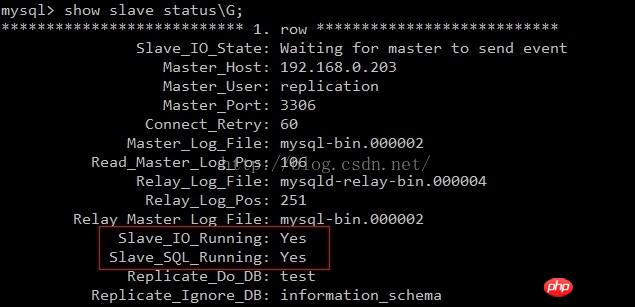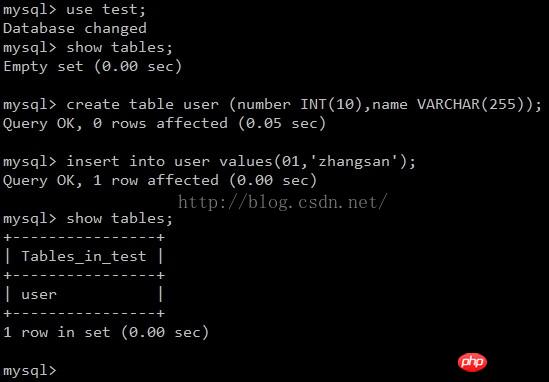 Database
Database
 Mysql Tutorial
Mysql Tutorial
 MySQL - Detailed explanation of dual-machine HA based on Keepalived (picture and text)
MySQL - Detailed explanation of dual-machine HA based on Keepalived (picture and text)
MySQL - Detailed explanation of dual-machine HA based on Keepalived (picture and text)
1. Environment description:
OS: CentOS6.5_X64
MASTER: 192.168.0.202
BACKUP: 192.168.0.203
VIP: 192.168.0.204
2. Configure two MysqlMaster-Master Synchronization
Regarding the installation of MySQL, you can also refer to "MySQL - CentOS6.5 Compile and Install MySQL5.6.16", the main Master synchronization configures the slave server as the master of the previous master server based on master-slave synchronization. It is equivalent to setting the original slave as the master of the original master based on the original master-slave synchronization. You can also refer to "MySQL - —MS master-slave replication (read-write separation) implementation》
, after setting A as B's Master and B as A's Slave, then set B as A's Master and A as B's Slave.
[root@masterr ~]# yum install mysql-server mysql -y [root@masterr ~]# service mysqld start [root@masterr ~]# mysqladmin -u root proot [root@masterr ~]# vi /etc/my.cnf #开启二进制日志,设置id [mysqld] server-id = 1 #backup这台设置2 log-bin = mysql-bin binlog-ignore-db = mysql,information_schema #忽略写入binlog日志的库 auto-increment-increment = 2 #字段变化增量值 auto-increment-offset = 1 #初始字段ID为1 slave-skip-errors = all #忽略所有复制产生的错误 [root@masterr ~]# service mysqld restart
#First check the log bin log and pos value location
[root@ master ~]# mysql -u root -proot
mysql> GRANT REPLICATION SLAVE ON *.* TO 'replication'@'192.168.0.%' IDENTIFIED BY 'replication';
mysql> flush privileges;
mysql> change master to
-> master_host='192.168.0.203',
-> master_user='replication',
-> master_password='replication',
-> master_log_file='mysql-bin.000002',
-> master_log_pos=106; #对端状态显示的值
mysql> start slave; #启动同步[root@backup ~]# mysql -u root -proot
mysql> GRANT REPLICATION SLAVE ON *.* TO 'replication'@'192.168.0.%' IDENTIFIED BY 'replication';
mysql> flush privileges;
mysql> change master to
-> master_host='192.168.0.202',
-> master_user='replication',
-> master_password='replication',
-> master_log_file='mysql-bin.000002',
-> master_log_pos=106;
mysql> start slave;


[root@backup ~]# yum install -y pcre-devel openssl-devel popt-devel #安装依赖包
Copy after login[root@masterr ~]# wget http://www.php.cn/
[root@masterr ~]# tar zxvf keepalived-1.2.7.tar.gz
[root@masterr ~]# cd keepalived-1.2.7
[root@masterr ~]#./configure --prefix=/usr/local/keepalived
make
Copy after login
#Configure keepalived as a system service[root@backup ~]# yum install -y pcre-devel openssl-devel popt-devel #安装依赖包
[root@masterr ~]# wget http://www.php.cn/ [root@masterr ~]# tar zxvf keepalived-1.2.7.tar.gz [root@masterr ~]# cd keepalived-1.2.7 [root@masterr ~]#./configure --prefix=/usr/local/keepalived make
[root@masterr ~]# cp /usr/local/keepalived/etc/rc.d/init.d/keepalived /etc/init.d/ [root@masterr ~]# cp /usr/local/keepalived/etc/sysconfig/keepalived /etc/sysconfig/ [root@masterr ~]# mkdir /etc/keepalived/ [root@masterr ~]# cp /usr/local/keepalived/etc/keepalived/keepalived.conf /etc/keepalived/ [root@masterr ~]# cp /usr/local/keepalived/sbin/keepalived /usr/sbin/
[root@masterr ~]# vi /etc/keepalived/keepalived.conf
! Configuration File forkeepalived
global_defs {
notification_email {
test@sina.com
}
notification_email_from admin@test.com
smtp_server 127.0.0.1
smtp_connect_timeout 30
router_id MYSQL_HA #标识,双主相同
}
vrrp_instance VI_1 {
state BACKUP #两台都设置BACKUP
interface eth0
virtual_router_id 51 #主备相同
priority 100 #优先级,backup设置90
advert_int 1
nopreempt #不主动抢占资源,只在master这台优先级高的设置,backup不设置
authentication {
auth_type PASS
auth_pass 1111
}
virtual_ipaddress {
192.168.0.204
}
}
virtual_server 192.168.0.204 3306 {
delay_loop 2
#lb_algo rr #LVS算法,用不到,我们就关闭了
#lb_kind DR #LVS模式,如果不关闭,备用服务器不能通过VIP连接主MySQL
persistence_timeout 50 #同一IP的连接60秒内被分配到同一台真实服务器
protocol TCP
real_server 192.168.0.202 3306 { #检测本地mysql,backup也要写检测本地mysql
weight 3
notify_down /usr/local/keepalived/mysql.sh #当mysq服down时,执行此脚本,杀死keepalived实现切换
TCP_CHECK {
connect_timeout 3 #连接超时
nb_get_retry 3 #重试次数
delay_before_retry 3 #重试间隔时间
}
}[root@masterr ~]# vi /usr/local/keepalived/mysql.sh #!/bin/bash pkill keepalived [root@masterr ~]# chmod +x /usr/local/keepalived/mysql.sh [root@masterr ~]# /etc/init.d/keepalived start
#The backup server only changes the priority to 90. Nopreempt is not set, real_server sets the local IP.
#Authorize two Mysql servers to allow root remote login for testing on other servers!
mysql> grant all on *.* to'root'@'192.168.0.%' identified by 'root'; mysql> flush privileges;
2) Stop the master mysql service and check whether it can switch to it normally. You can use the ip addr command to check which server the VIP is on.  3) You can see the master/backup switching process by checking the /var/log/messges log
3) You can see the master/backup switching process by checking the /var/log/messges log
4) After the master server recovers from a fault, whether it actively seizes resources and becomes an active server.
Note: The order of service startup: start MySQL first, then Keepalived.
The above is the detailed content of MySQL - Detailed explanation of dual-machine HA based on Keepalived (picture and text). For more information, please follow other related articles on the PHP Chinese website!

Hot AI Tools

Undresser.AI Undress
AI-powered app for creating realistic nude photos

AI Clothes Remover
Online AI tool for removing clothes from photos.

Undress AI Tool
Undress images for free

Clothoff.io
AI clothes remover

Video Face Swap
Swap faces in any video effortlessly with our completely free AI face swap tool!

Hot Article

Hot Tools

Notepad++7.3.1
Easy-to-use and free code editor

SublimeText3 Chinese version
Chinese version, very easy to use

Zend Studio 13.0.1
Powerful PHP integrated development environment

Dreamweaver CS6
Visual web development tools

SublimeText3 Mac version
God-level code editing software (SublimeText3)

Hot Topics
 1386
1386
 52
52
 MySQL: Simple Concepts for Easy Learning
Apr 10, 2025 am 09:29 AM
MySQL: Simple Concepts for Easy Learning
Apr 10, 2025 am 09:29 AM
MySQL is an open source relational database management system. 1) Create database and tables: Use the CREATEDATABASE and CREATETABLE commands. 2) Basic operations: INSERT, UPDATE, DELETE and SELECT. 3) Advanced operations: JOIN, subquery and transaction processing. 4) Debugging skills: Check syntax, data type and permissions. 5) Optimization suggestions: Use indexes, avoid SELECT* and use transactions.
 How to open phpmyadmin
Apr 10, 2025 pm 10:51 PM
How to open phpmyadmin
Apr 10, 2025 pm 10:51 PM
You can open phpMyAdmin through the following steps: 1. Log in to the website control panel; 2. Find and click the phpMyAdmin icon; 3. Enter MySQL credentials; 4. Click "Login".
 MySQL: An Introduction to the World's Most Popular Database
Apr 12, 2025 am 12:18 AM
MySQL: An Introduction to the World's Most Popular Database
Apr 12, 2025 am 12:18 AM
MySQL is an open source relational database management system, mainly used to store and retrieve data quickly and reliably. Its working principle includes client requests, query resolution, execution of queries and return results. Examples of usage include creating tables, inserting and querying data, and advanced features such as JOIN operations. Common errors involve SQL syntax, data types, and permissions, and optimization suggestions include the use of indexes, optimized queries, and partitioning of tables.
 How to use single threaded redis
Apr 10, 2025 pm 07:12 PM
How to use single threaded redis
Apr 10, 2025 pm 07:12 PM
Redis uses a single threaded architecture to provide high performance, simplicity, and consistency. It utilizes I/O multiplexing, event loops, non-blocking I/O, and shared memory to improve concurrency, but with limitations of concurrency limitations, single point of failure, and unsuitable for write-intensive workloads.
 Why Use MySQL? Benefits and Advantages
Apr 12, 2025 am 12:17 AM
Why Use MySQL? Benefits and Advantages
Apr 12, 2025 am 12:17 AM
MySQL is chosen for its performance, reliability, ease of use, and community support. 1.MySQL provides efficient data storage and retrieval functions, supporting multiple data types and advanced query operations. 2. Adopt client-server architecture and multiple storage engines to support transaction and query optimization. 3. Easy to use, supports a variety of operating systems and programming languages. 4. Have strong community support and provide rich resources and solutions.
 MySQL's Place: Databases and Programming
Apr 13, 2025 am 12:18 AM
MySQL's Place: Databases and Programming
Apr 13, 2025 am 12:18 AM
MySQL's position in databases and programming is very important. It is an open source relational database management system that is widely used in various application scenarios. 1) MySQL provides efficient data storage, organization and retrieval functions, supporting Web, mobile and enterprise-level systems. 2) It uses a client-server architecture, supports multiple storage engines and index optimization. 3) Basic usages include creating tables and inserting data, and advanced usages involve multi-table JOINs and complex queries. 4) Frequently asked questions such as SQL syntax errors and performance issues can be debugged through the EXPLAIN command and slow query log. 5) Performance optimization methods include rational use of indexes, optimized query and use of caches. Best practices include using transactions and PreparedStatemen
 MySQL and SQL: Essential Skills for Developers
Apr 10, 2025 am 09:30 AM
MySQL and SQL: Essential Skills for Developers
Apr 10, 2025 am 09:30 AM
MySQL and SQL are essential skills for developers. 1.MySQL is an open source relational database management system, and SQL is the standard language used to manage and operate databases. 2.MySQL supports multiple storage engines through efficient data storage and retrieval functions, and SQL completes complex data operations through simple statements. 3. Examples of usage include basic queries and advanced queries, such as filtering and sorting by condition. 4. Common errors include syntax errors and performance issues, which can be optimized by checking SQL statements and using EXPLAIN commands. 5. Performance optimization techniques include using indexes, avoiding full table scanning, optimizing JOIN operations and improving code readability.
 Monitor Redis Droplet with Redis Exporter Service
Apr 10, 2025 pm 01:36 PM
Monitor Redis Droplet with Redis Exporter Service
Apr 10, 2025 pm 01:36 PM
Effective monitoring of Redis databases is critical to maintaining optimal performance, identifying potential bottlenecks, and ensuring overall system reliability. Redis Exporter Service is a powerful utility designed to monitor Redis databases using Prometheus. This tutorial will guide you through the complete setup and configuration of Redis Exporter Service, ensuring you seamlessly build monitoring solutions. By studying this tutorial, you will achieve fully operational monitoring settings



